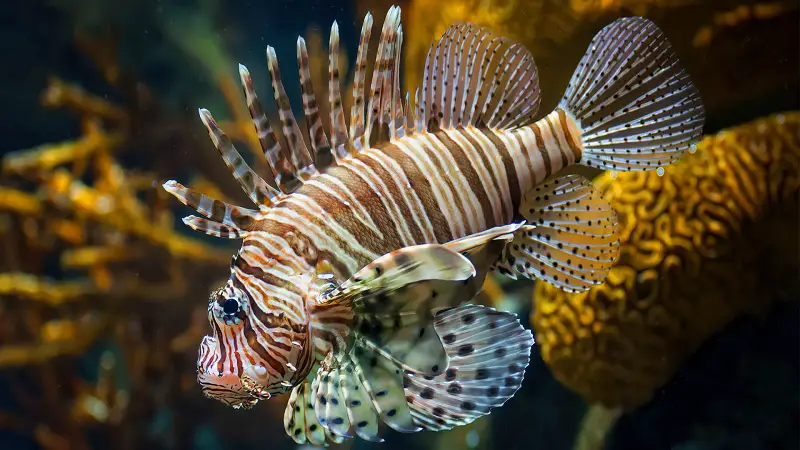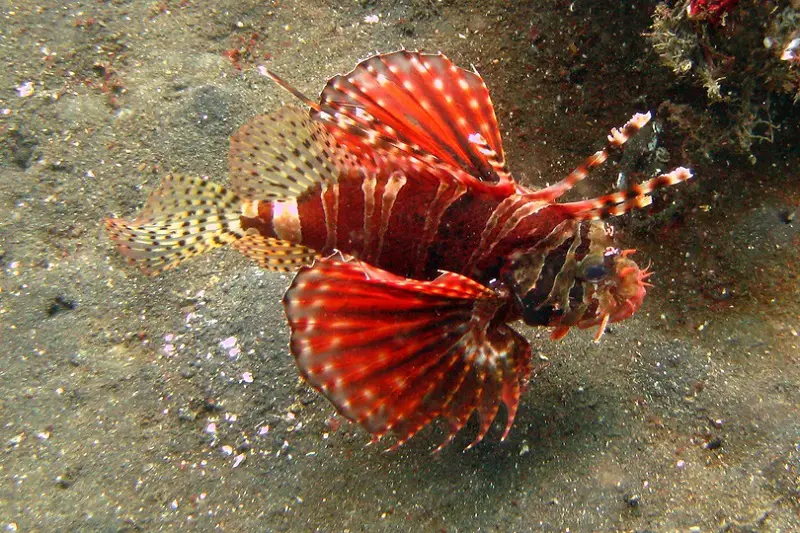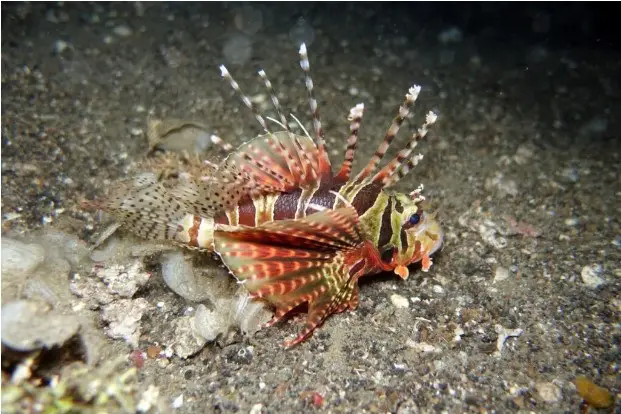The vast and mesmerizing world of marine life is home to an array of captivating creatures, each with its unique set of characteristics and adaptations.
In this blog post, we dive deep into the underwater realm to explore the intriguing contrast between two striking marine species: lionfish vs turkeyfish.
While both creatures share a penchant for vibrant colors and captivating appearances, their differences extend beyond the surface.
You’ll discover the distinctive features, habitats, behaviors, and ecological significance of these two fascinating marine residents.
Without any more delay, let’s get started.
Lionfish vs Turkeyfish (Differences & Similarities)

When it comes to vibrant and flamboyant marine creatures, both lionfish and turkeyfish certainly make a statement. Slightly different in appearance yet equally mesmerizing, these two species often leave divers and underwater enthusiasts captivated by their exotic beauty. While the names may suggest a rivalry or even a battle between them, the reality is quite different.
Lionfish, with their striking red and white stripes adorned with flowing pectoral fins, have earned their reputation as skilled hunters. Equipped with venomous spines, they are efficient predators that can quickly devour smaller fish within seconds. However, when comparing lionfish to turkeyfish, also known as scorpionfish or stonefish, one significant difference arises – camouflage. Turkeyfish possess an incredible ability to blend seamlessly into their surroundings due to their intricate patterns and color variations. This allows them to patiently lie in wait for unsuspecting prey before snatching it up in a rapid strike fueled by sheer instinct.

Despite the apparent differences between these two remarkable sea creatures, they share a fascinating characteristic: aposematism. Both the lionfish and turkeyfish display bright colors as an evolutionary adaptation warning predators of their toxicity or venomous nature. In this way, each species challenges preconceived notions about the role of coloration in the animal kingdom – acting both as protection from potential threats while simultaneously attracting attention from humans who marvel at their beauty.
Lionfish vs Turkeyfish (Physical Characteristics and Appearance)
Lionfish and turkeyfish are two visually stunning creatures that share a similar appearance but possess distinct physical characteristics. Both species belong to the family Scorpaenidae, commonly known as scorpionfish. However, lionfish are notorious for their venomous spines and vibrant coloration, while turkeyfish display an impressive array of patterns and textures.
One of the most striking differences between these two fish lies in their spines. Lionfish boast long, venomous spines that can inflict painful stings on unsuspecting predators or humans. These spines serve as both defense mechanisms and hunting tools for lionfish, allowing them to immobilize small prey before devouring it whole. In contrast, turkeyfish have shorter and less poisonous spines that are primarily employed for protection rather than hunting.
When it comes to coloration, lionfish seem to outshine their turkeyish counterparts with flamboyant stripes and vivid hues of reds, oranges, and whites. This ostentatious display serves as a warning sign to potential predators about their venomous capabilities. On the other hand, turkeyish exhibit an extraordinary range of patterns resembling intricate mosaics or rich tapestries blending into their surrounding environments. These markings enable them to camouflage seamlessly amongst coral reefs or estuary bottoms where they reside.
While both lionfish and turkeyish share certain physical characteristics due to belonging in the same scorpionfish family; however they differ in terms of spine structure and colors.
Lionfish vs Turkeyfish (Habitat and Distribution)
Lionfish and turkeyfish, despite their different names, are two common names for the same species: Pterois volitans.

Found in the Indo-Pacific region, these venomous creatures have notorious reputations as invasive species in non-native habitats. However, their distribution patterns and preferred habitats reveal interesting distinctions between the two names.
The lionfish received its name due to its majestic appearance and hunting abilities. It prefers to dwell in coral reefs with moderate visibility and strong currents, often found at depths of up to 50 meters.
On the other hand, the term turkeyfish emphasizes a different side of this intriguing creature’s behavior and habitat choice.
Turkeyfish can be found in lagoons with sand or seagrass bottoms, where they blend seamlessly into their surroundings.

These distinct preferences suggest that while both lionfish and turkeyfish belong to the same species, they have adapted differently based on factors such as food availability and competition within their respective environments.
Understanding these differences allows researchers to gain insights into how environmental changes may impact these species’ survival rates in their native regions as well as newly invaded areas like the Atlantic Ocean.
Such knowledge is crucial for devising effective strategies to mitigate their harmful effects on ecosystems already facing numerous challenges from human activities and climate change.
Lionfish vs Turkeyfish (Venomous Spines and Defense Mechanisms)
Lionfish and turkeyfish are both fascinating creatures with unique qualities that set them apart from other marine species. One of the most striking features of these fish is their venomous spines, which serve as an important defense mechanism. However, despite their similarities, there are some key differences in the way these two fish use their venomous spines.
Lionfish have long, elaborate spines that protrude from their bodies like a crimson crown. Their venom is stored within specialized cells located at the base of each spine, and when threatened, they can inject this potent toxin into any potential predator. This not only deter predators but also incapacitates the prey for easy consumption. On the other hand, turkeyfish have shorter yet equally dangerous spines that contain a similar venomous payload. However, what sets them apart from lionfish is their ability to change color and pattern to blend seamlessly with their surroundings as a camouflage technique while using their venomous spines more selectively for defense.
Lionfish and turkeyfish may share similar characteristics with regards to their venomous spines as a means of self-defense; however, they employ different strategies in utilizing these specialized weapons. Lionfish rely on their bold display of brightly colored spikes to warn off predators and immobilize prey, while turkeyfish adopt a more subtle approach by camouflaging themselves to avoid detection and resorting to injecting venom only when necessary.
Lionfish vs Turkeyfish (Feeding Habits and Diet)
The lionfish and the turkeyfish are two mesmerizing species that excel in both beauty and hunting skills. Despite their different names, they actually belong to the same family of marine creatures known as Scorpaenidae. When it comes to feeding habits, these captivating fish share some striking similarities.
Both lionfish and turkeyfish are carnivorous predators, known for their voracious appetites. They mainly feed on small fish and crustaceans. However, what sets them apart is their hunting tactics. Lionfish are ambush predators who rely on camouflage to blend seamlessly with their surroundings before ambushing unsuspecting prey with their lightning-fast strikes. On the other hand, turkeyfish use a combination of stealth and agility while swimming among coral reefs or rocky habitats in search of food.
One notable difference between the feeding habits of these two awe-inspiring species lies in their diet preferences. While lionfish primarily target small fish species such as gobies and damselfish, turkeyfish have been observed preying on a wider range of creatures like crabs, shrimp, mollusks, and even smaller octopuses! This diverse diet indicates that turkeyfish possess a more adaptable palate compared to the slightly more specific preferences of the lionfish.
Although lionfish and turkeyfish may seem remarkably similar at first glance due to belonging to the same family of Scorpaenidae, they demonstrate distinct differences in behavior when it comes to feeding habits.
Lionfish vs Turkeyfish (Hunting Techniques and Behavior)
Lionfish and turkeyfish, both known for their stunning beauty and vibrant colors, may share some similarities in appearance, but when it comes to hunting techniques and behavior, they couldn’t be more different. Lionfish, with their mesmerizing long fins and venomous spines, are ambush predators. They patiently wait in hiding spots among coral reefs for their unsuspecting prey to swim by. Then, with lightning-fast precision, they extend their large mouths to engulf small fish and crustaceans.
On the other hand, turkeyfish possess striking patterns that make them appear as if dressed for a formal affair. While they also rely on camouflage during the hunt, these clever creatures choose a more active approach. Instead of lurking in shadows like lionfish, turkeyfish actively stalk their prey on the sandy ocean floor. With stealthy movements resembling those of a tiger stalking its quarry on land, turkeyfish slowly approach their victims before suddenly propelling themselves forward to snatch up an unwary fish or shrimp.
While lionfish excel at being patient ambush predators amidst coral reefs with deadly venomous strikes from concealment; turkeyfish utilize unique predatory tactics that involve actively pursuing prey on sandy ocean floors to achieve success. The contrasting hunting techniques and behaviors of these two magnificent species provide fascinating insights into the intricate world of marine life strategies for survival.
Lionfish vs Turkeyfish (Interaction with Humans)
Lionfish and turkeyfish, both known for their vibrant colors and unique appearances, have captivated the attention of humans for centuries. However, their interaction with us couldn’t be more different. Lionfish, often found in tropical waters, has earned a notorious reputation due to its venomous spines and aggressive behavior when threatened. In recent years, lionfish populations have exploded in some areas, causing concern among divers and fishermen who fear the negative impact on local ecosystems.
On the other hand, turkeyfish – also known as scorpionfish or zebra fish – exhibit a less confrontational demeanor towards humans. These striking creatures sport ornate patterns that help them blend seamlessly into coral reefs and rocky substrates. Despite being capable of inflicting painful stings if provoked or stepped on accidentally, turkeyfish tend to avoid human contact whenever possible.
The contrasting behaviors exhibited by these two species highlight an interesting aspect of human-wildlife interactions: poisonous or dangerous animals can either elicit fear or fascination amongst us. While lionfish’s aggressive nature leads to containment efforts such as hunting tournaments and targeted fishing expeditions to control their population growth in certain regions like the Caribbean Sea, turkeyfish’s more reclusive behavior allows for peaceful coexistence with humans underwater. Understanding these differences is crucial to ensure our safety while appreciating the beauty of marine life in our oceans.
Lionfish vs Turkeyfish (Summary)
While both lionfish and turkeyfish are visually stunning creatures, they have distinct differences in their physical appearance, behavior, and habitat.
Lionfish possess venomous spines and are known for their aggressive hunting techniques, making them a threat to marine ecosystems.
On the other hand, turkeyfish have vibrant colors to blend in with their surroundings and rely on camouflage for survival. Understanding these differences is crucial in order to properly identify and address the potential risks posed by lionfish.
It’s imperative that we continue to educate ourselves and take proactive measures to control their population growth, such as promoting responsible fishing practices and encouraging the consumption of lionfish as a means of conservation.
Other Blog Posts